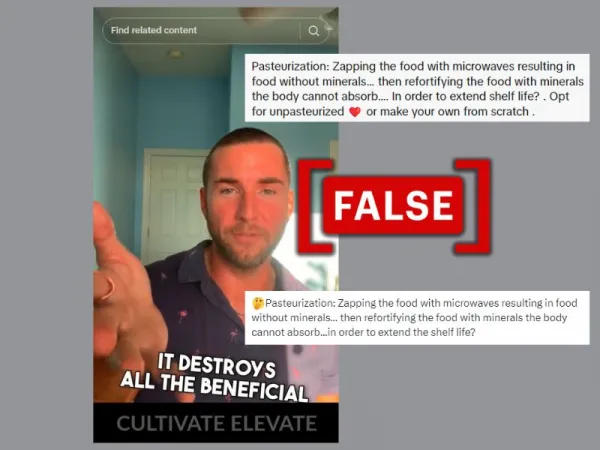By: Praveen Kumar
January 11 2024
Pasteurizing and fortifying milk do not make it nutrient-deficient or synthetic

A video of a man making an incorrect claim that pasteurizing milk zaps away all its nutrients and fortifying it with vitamins makes it synthetic is being circulated on social media. (Source: TikTok/X/Screenshots/Modified by Logically Facts)
The Verdict False
Pasteurization is a food processing method that uses a mild heat treatment. It does not eliminate nutrients from milk or make it a synthetic food.
What is the claim?
A video shared on TikTok with thousands of views shows a man incorrectly claiming the pasteurization process causes milk to become nutrient-deficient.
The video claims that microwave technology used to pasteurize milk "zaps" away minerals and enzymes, and fortifying it with vitamins makes it synthetic. This video has been circulated by a lifestyle company named Cultivate Elevate, and other users on TikTok (archived here, here, and here) and Instagram (archived here).
This claim has been circulating on TikTok since November 2023. (Source: TikTok/Screenshots/Modified by Logically Facts)
It has also been shared on X (archived here) and Telegram where it has garnered over 38,000 views.
This claim has also been shared on X and Telegram. (Source: X/Telegram/Screenshots)
However, this claim about pasteurization of milk is not true.
What we found
Introduced in the 1880s, pasteurization of milk is a heat treatment process that extends the shelf life of milk by killing harmful bacteria and inhibiting enzyme activity. According to ScienceDirect, it is a relatively mild process, compared to sterilization, which involves heating food to a high enough temperature to kill all bacteria. Pasteurization preserves the nutrients and flavor of the milk while still eliminating harmful bacteria. This process kills 99.99 percent of harmful bacteria, including E. coli, Listeria, Salmonella, and Campylobacter.
Pasteurized milk is less likely to cause foodborne illness, and it also has a more consistent flavor and texture than raw milk. According to the International Dairy Foods Association, the most common method of pasteurization in the U.S. is High Temperature Short Time (HTST) pasteurization, which involves using metal plates and hot water to raise milk temperatures to 72°C (161°F) for 15 seconds.
According to the Hong Kong Centre for Food Safety, in addition to extending the shelf life of milk, pasteurization also helps to improve its safety and quality.
Pasteurization and nutritional value
Scientific nutrition information website Dairy Nutrition states pasteurization does not significantly affect the nutritional value of milk, except for a slight decrease in vitamin B and C content. However, while milk is not a major source of vitamin C, even pasteurized milk still contains a significant amount.
A 2012 study by Australia’s Charles Sturt University concluded that pasteurizing milk with microwaves did not have any negative effects on its nutritional value. A 2023 study from Xianyang’s Northwest A&F University in China found that microwave heating at 300 W for 2 minutes was beneficial to the retention of nutrients and the maintenance of protein stability in bovine milk samples.
Logically Facts reached out to Dr. Christopher Gardner, a nutrition scientist and a Professor of Medicine at Stanford University, regarding the effects of pasteurizing milk on its nutritional value. He said, "Minerals can’t be destroyed. They are atomic elements. They can be bound/trapped and removed, but not destroyed. Enzymes can be destroyed by heat. But enzymes are also destroyed by acidic pH, like the low pH in the stomach. It is likely most enzymes in milk if not exposed to pasteurization and denatured (rendered inactive) that way, would be denatured by stomach acid. Pasteurization is intended to primarily kill pathogens."
'Refortification'
In the viral video, the term "refortified" with vitamins may refer to fortification. Upon research, we found that there isn’t a food processing industry term called "refortification". Dr. Gardner told us, "Vitamin D isn’t in raw milk. It is a fat-soluble vitamin. Milk has fat. It is a useful way to incorporate vitamin D into foods. Milk is fortified with vitamin D, but not "refortified", and it isn’t done to extend shelf life, but to improve overall nutritional quality."
The Food Safety and Standards Authority of India (FSSAI) defines fortification as "deliberately increasing the content of essential micronutrients in a food so as to improve the nutritional quality of food and to provide public health benefit with minimal risk to health." Most food safety authorities worldwide have similar definitions and regulations. While vitamin D fortification of milk is voluntary in most regions, countries like Canada have made it mandatory.
Not 'synthetic'
Although no specific definition of "synthetic food" by any major regulatory body exists, the World Health Organization, the U.S. Food and Drug Administration, the European Union, and others define terms such as additives, novel foods, and ultra-processed food. The Food and Agriculture Organization of the United Nations (FAO) refers to milk and milk products that have been processed to make it safe for public consumption as "processed." Therefore referring to pasteurized milk that comes in packages as "synthetic" is incorrect.
The verdict
Over a century of scientific studies and practices have ensured pasteurization of milk makes it safe for public consumption and experts have also confirmed to Logically Facts that it is a safe method of preserving milk. Therefore we have marked this claim as false.


